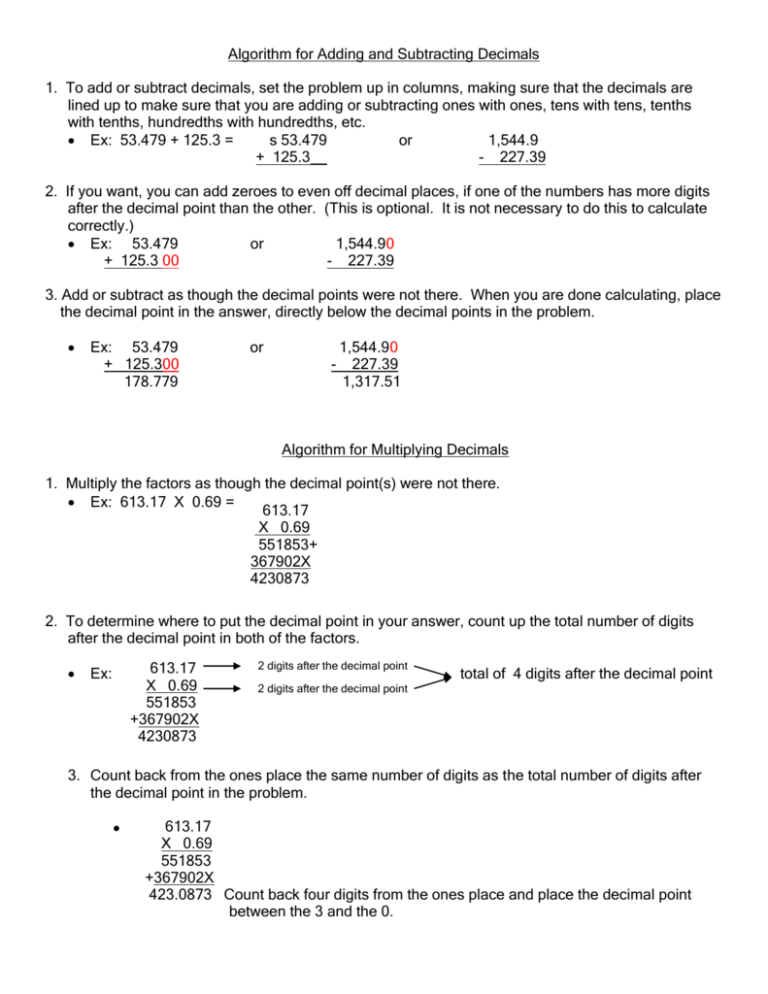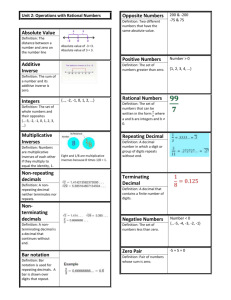Algorithm for Adding and Subtracting Decimals
advertisement

Algorithm for Adding and Subtracting Decimals 1. To add or subtract decimals, set the problem up in columns, making sure that the decimals are lined up to make sure that you are adding or subtracting ones with ones, tens with tens, tenths with tenths, hundredths with hundredths, etc. Ex: 53.479 + 125.3 = s 53.479 or 1,544.9 + 125.3__ - 227.39 2. If you want, you can add zeroes to even off decimal places, if one of the numbers has more digits after the decimal point than the other. (This is optional. It is not necessary to do this to calculate correctly.) Ex: 53.479 or 1,544.90 + 125.3 00 - 227.39 3. Add or subtract as though the decimal points were not there. When you are done calculating, place the decimal point in the answer, directly below the decimal points in the problem. Ex: 53.479 + 125.300 178.779 or - 1,544.90 227.39 1,317.51 Algorithm for Multiplying Decimals 1. Multiply the factors as though the decimal point(s) were not there. Ex: 613.17 X 0.69 = 613.17 X 0.69 551853+ 367902X 4230873 2. To determine where to put the decimal point in your answer, count up the total number of digits after the decimal point in both of the factors. 613.17 X 0.69 551853 +367902X 4230873 Ex: 2 digits after the decimal point total of 4 digits after the decimal point 2 digits after the decimal point 3. Count back from the ones place the same number of digits as the total number of digits after the decimal point in the problem. 613.17 X 0.69 551853 +367902X 423.0873 Count back four digits from the ones place and place the decimal point between the 3 and the 0. Algorithm for Dividing Decimals 1. When dividing with decimals, you cannot have a decimal point in the divisor, (the number, after the division sign or outside the box). (It is OK to have one in the dividend, the number before the division sign or inside the box.) 2. If the divisor in the problem does have a decimal point, it must be moved to the right so that the divisor is a whole number. To do that you must think of the division problem as a fraction. Then make an equivalent fraction by multiplying the numerator and denominator by a number that will move the decimal point the appropriate number of places to the right, to make the divisor (the denominator of the fraction) a whole number. Ex: 782 ÷ 0.25 = Ex: 782 0.25 X 100 X 100 = 78200 25 3. Divide 3128 25 78200 4. If after step 2 you have a decimal point in the dividend (the number inside the box), divide as though the decimal point was not there. When you are finished calculating, place the decimal point in your answer, directly above the decimal point in the dividend, so that the number of digits after the decimal point in the answer is the same as the number of digits after the decimal point in the dividend. 6.55 Ex: 6.55 ÷ 0.5 = 0 .5 X 10 X 10 13.1 65.5 = = 5 65.5 5





